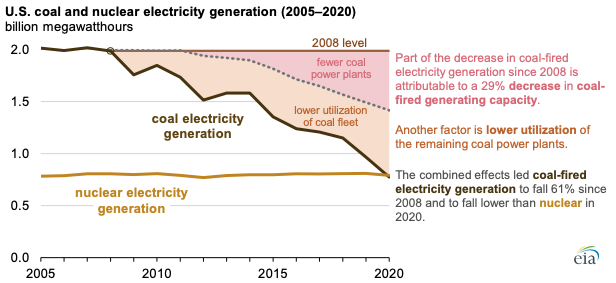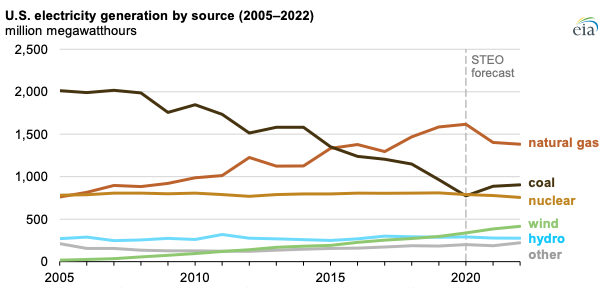U.S. coal-fired electricity generated totaled 774 million megawatthours (MWh) in 2020, which is less than both natural gas-fired (1.6 billion MWh) and nuclear-powered generation (790 million MWh), according to the U.S. Energy Information Administration’s (EIA) Electric Power Monthly. Last year marked the first time that coal was not the largest or second-largest source of annual electricity generation in the United States since at least 1949. However, EIA expects U.S. coal-fired electricity generation to increase and for nuclear-powered electricity generation to decrease in both 2021 and 2022.

Coal-fired electricity generation in the United States has continued to decrease as coal-fired generating units have been retired or converted to use other fuels and as the remaining coal-fired generating units have been used less often. U.S. operating coal-fired electricity generation capacity measured 313 gigawatts (GW) in 2008. In that year, the earliest for which EIA’s State Electricity Profiles have capacity factor data, coal’s capacity factor was 72%. Capacity factors measure the actual generation output for a fleet of generators as a percentage of what those generators are capable of generating. By 2020, coal’s operating capacity had fallen to 223 GW, and the coal fleet’s capacity factor had fallen to 40%.
In the most recent Short-Term Energy Outlook, EIA expects U.S. coal-fired generation to increase and for nuclear-powered generation to decrease in both 2021 and 2022. EIA expects that increases in natural gas prices will make coal more competitive in the electric power sector. This expected increase in coal’s utilization more than offsets the upcoming retirement of 2.8 GW of coal capacity in 2021 and another 8.5 GW in 2022, according to planned changes reported to EIA by owners and developers and compiled in EIA’s Preliminary Monthly Electric Generator Inventory.

EIA expects nuclear-powered electricity generation to decrease because three nuclear plants (totaling 5.1 GW of capacity) plan to retire in 2021. Another plant, Michigan’s Palisades, plans to retire in 2022. One nuclear power plant, Vogtle, in Georgia, plans to add 1.1 GW of capacity in November 2021 and 1.1 GW in November 2022, based on information reported to EIA.
Principal contributor: Owen Comstock






